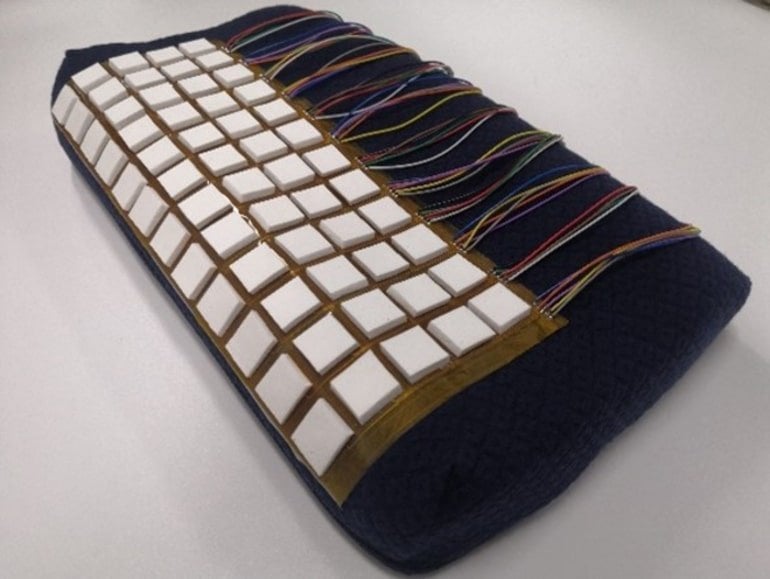Summary: A newly designed “smart pillow” that tracks the position of the head during sleep could help to track and monitor sleep quality and duration in those with sleep disorders.
Source: American Chemical Society
The human body needs sleep as much as it needs food and water. Yet many people fail to get enough, causing both mind and body to suffer. People who struggle for shut-eye could benefit from monitoring their sleep, but they have limited options for doing so.
In a new study in ACS Applied Materials & Interfaces, one team describes a potential solution: a self-powering smart pillow that tracks the position of the head.
Studies have linked chronic lack of sleep to physical ailments, such as diabetes and heart disease, as well as mental health issues. Those interested in getting a better handle on what’s happening to them at night have two primary options. They can take a sleep test conducted in a medical facility, or they can use an app through a smartphone or smart watch — a much more convenient, but less accurate choice.
Recognizing the need, many groups have begun developing new sleep monitoring systems using triboelectric nanogenerators (TENGs). These self-powering systems have taken the form of eye masks, belts, patches and even bed sheets.
Ding Li, Zhong Lin Wang and their colleagues wanted to adapt this approach to create a less restrictive, more comfortable version that focuses on the movement of the head during sleep.
To construct this new smart pillow, the researchers formulated a flexible, porous polymer triboelectric layer. Movement between the head and this layer changes the electric field around nearby electrodes, generating a current. They strung together several of these self-powering sensors to create a flexible and breathable TENG (FB-TENG) array that can be placed atop an ordinary pillow.
This system could generate voltage that corresponded to the amount of applied pressure, and it could track the movement of a finger tracing out letters. The FB-TENG also could capture the pressure distribution of a fake human head as it shifted position.

This smart pillow could have uses beyond tracking sleep, the researchers say. For example, the system could monitor patients with diseases that affect the movement of the head, such as the degenerative neck disorder cervical spondylosis.
What’s more, the smart pillow could be adapted to offer an early warning system for those at risk of falling out of bed, they say.
The authors acknowledge funding from the National Key Research & Development Project from the Ministry of Science and Technology of the People’s Republic of China and the National Natural Science Foundation of China.
About this neurotech and sleep research news
Author: Katie Cottingham
Source: American Chemical Association
Contact: Katie Cottingham – American Chemical Association
Image: The image is credited to Haiying Kou
Original Research: Closed access.
“Smart Pillow Based on Flexible and Breathable Triboelectric Nanogenerator Arrays for Head Movement Monitoring during Sleep” by Haiying Kou et al. ACS Applied Materials and Interfaces
Abstract
Smart Pillow Based on Flexible and Breathable Triboelectric Nanogenerator Arrays for Head Movement Monitoring during Sleep
Sleep quality plays an essential role in human health and has become an index for assessing physical health. Self-powered, sensitive, noninvasive, comfortable, and low-cost sleep monitoring sensors for monitoring sleep behavior are still in high demand.
Here, a pressure-sensitive, noninvasive, and comfortable smart pillow is developed based on a flexible and breathable triboelectric nanogenerator (FB-TENG) sensor array, which can monitor head movement in real time during sleep.
The FB-TENG is based on flexible and breathable porous poly(dimethylsiloxane) (PDMS) with a fluorinated ethylene propylene (FEP) powder and exhibits pressure sensitivity and durability.
The electrical output of the FB-TENG is further optimized by modifying the porous structure and the FEP powder. Combining the FB-TENG and the flexible printed circuit (FPC), a self-powered pressure sensor array is fabricated to realize touch sensing and motion track monitoring.
The smart pillow is formed by laying the self-powered pressure sensor array on an ordinary pillow to realize real-time monitoring of the head position in a static state and head movement trajectory in a dynamic state during sleep. Additionally, the smart pillow also has an early warning function for falling out of bed.
This work not only provides a viable sensing device for sleep monitoring but also could be extended to real-time monitoring of some diseases, such as brain diseases and cervical spondylosis, in the future. It is expected to introduce a practical strategy in the real-time mobile healthcare field for disease management.







